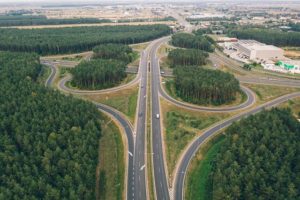 Recent research from the Mercatus Center argues that drone highways situated over existing public roads could be the fastest way to full integration of commercial drones.
Recent research from the Mercatus Center argues that drone highways situated over existing public roads could be the fastest way to full integration of commercial drones.
The Mercatus Center research, written by senior fellow Brent Skorup and Harvard University JD student Connor Haaland rank the 50 U.S. states in terms of readiness for the drone industry. The researchers cite significant “ambiguity in federal and state roles over airspace management for drones” as a major barrier to readiness. The researchers see a solution, however: an agreement between federal and state governments to implement “drone highways” over existing public roads.
Drone technology has made major strides: autonomy, safety, reliability and ruggedness have all improved. Drone regulations have also moved forward: remote ID, flight at night, and flight over people and vehicles have all been regularized. Before commercial drones can be fully integrated into the airspace over communities, however, the often discussed gray areas of public airspace over private property must be made clear. The Mercatus report ranks the 50 states on readiness for commercial drones based on the following criteria:
-
Airspace lease law (30 points): Drone highways must be demarcated by regulators and safely separated from airports, homes, schools, and other sensitive locations. Leasing airspace above public property would accelerate drone services because creating flight paths over backyards and private lands raises issues about the taking of private property.
-
Law vesting air rights with landowners (10 points): This clarifies that the state is exercising its police powers and defining property rights—and puts drone operators and residents on notice about the extent of those rights. Where state or local authorities own public rights-of-way, air rights laws recognize their property interest in the aerial corridors above public roads.
-
Avigation easement law (25 points): This allows drones to operate as long as they are high enough not to bother landowners and passersby. If the state or municipality does not own aerial corridors above public roads, drones can still generally access the aerial easements if state officials demarcate drone highways above public roads.
-
Drone task force or program office (20 points): These bodies help anticipate (and address) issues such as zoning rules, noise limits, time-of-day restrictions, insurance, and privacy for private dwellings.
-
Drone jobs estimate (15 points): The number of drone jobs per 100,000 residents is a proxy for soft factors (e.g., a college offering drone programs or workers in the aerospace industry) that can position states for future jobs and services growth.
From these, Skorup and Haaland find that states with exceptional drone rules are North Dakota, Arkansas, Oklahoma, Nevada, and Virginia. The states with the most room for improvement are Nebraska, Rhode Island, Iowa, Mississippi, and Kentucky.
While it would not resolve all of the issues, allowing drones to fly over public roads could make it easier for commercial drone operations to find clarity – quickly and easily – over where flight is and is not allowed.

Miriam McNabb is the Editor-in-Chief of DRONELIFE and CEO of JobForDrones, a professional drone services marketplace, and a fascinated observer of the emerging drone industry and the regulatory environment for drones. Miriam has penned over 3,000 articles focused on the commercial drone space and is an international speaker and recognized figure in the industry. Miriam has a degree from the University of Chicago and over 20 years of experience in high tech sales and marketing for new technologies.
For drone industry consulting or writing, Email Miriam.
TWITTER:@spaldingbarker
Subscribe to DroneLife here.







[…] Mercatus Center research suggests that drone highways could be the fastest way to eliminate “ambiguity” in state and federal drone regs. Source […]